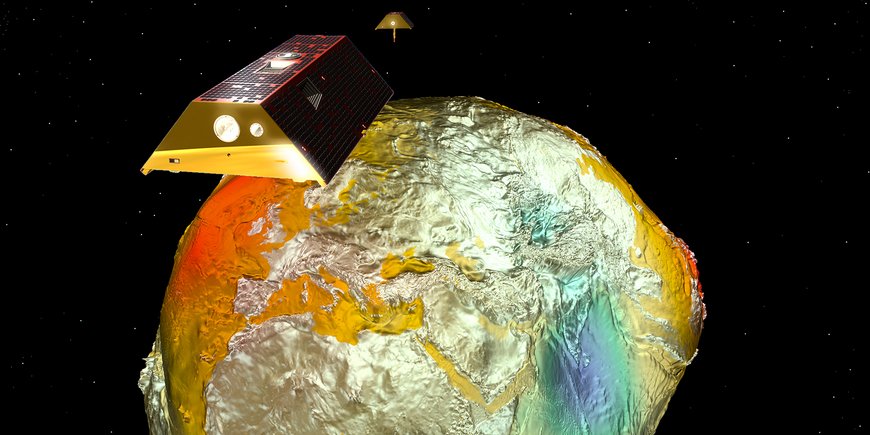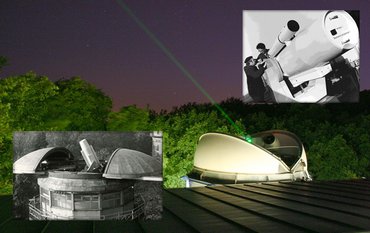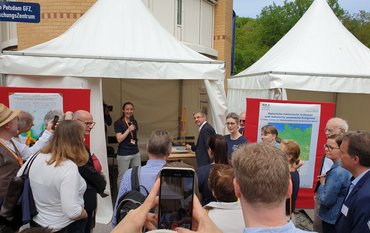Summary
The German Space Agency at the German Aerospace Center (DLR) and the US space agency NASA are continuing their gravity field measurements from space together with the GFZ German Research Centre for Geosciences and other partners. GRACE-C is expected to continue the measurements of the GRACE-FO satellite duo (in orbit since 2018) from 2028 onwards. C stands for Continuity and FO for Follow-On, as the two missions are the respective continuations of the original GRACE mission, which orbited the Earth from 2002 to 2017. Their measuring principle is still considered revolutionary and the data they provide is an important basis for the reports of the Intergovernmental Panel on Climate Change (IPCC), among other things. The German contribution to GRACE-C is being implemented with funding from the German Ministry of Economic Affairs and Climate Action (BMWK) and the Federal Ministry of Education and Research (BMBF) with the participation of the GFZ in Potsdam and the Max Planck Institute for Gravitational Physics (Albert Einstein Institute) in Hanover.
Monthly maps of gravity
In the last twenty years, the terrestrial water storage in Germany has lost a total of more than 15 billion tons of water. The loss of ice mass on Greenland has shown an even more dramatic downward trend – Greenland is losing more than 200 billion tons of ice every year. These values are provided by a unique satellite mission called the "Gravity Recovery and Climate Experiment", GRACE for short, based on continuous measurements of the Earth's gravitational field. The changes recorded in monthly maps allow conclusions about mass shifts across the globe. In particular, short-term, but also long-term changes in water masses can be quantified and tracked in this way.
The measuring principle is based on the fact that the gravitational force on the earth is not the same everywhere. The gravitational pull varies depending on the mass on the Earth's surface and below, for example due to different densities of rock or oceans and mountains. The two satellites in the GRACE duo, which fly behind each other at an altitude of around 500 km and a distance of around 200 km, "sense" this. The stronger the gravity, i.e. the more mass there is under the satellites, the more the leading satellite is attracted by it as it flies over. This causes it to accelerate and move away from the following satellite. The trailing satellite is only accelerated later by the stronger gravity, so that the satellites approach each other again. These minimal changes in the mutual distance are measured continuously over each orbit around the earth – in the case of GRACE-C with an accuracy of 200 to 300 picometers, the diameter of an atom. Thus, the satellites indirectly observe the Earth's gravitational field.
The original GRACE duo, which was launched in 2002 and flew until 2017, used slightly less precise microwaves to measure distances. In 2018, GRACE Follow-On was launched with a technology demonstrator from the Max Planck Institute for Gravitational Physics. This laser ranging interferometer (LRI) measures in parallel with the continuing microwave measurement and has impressively demonstrated its precision in recent years. GRACE-C (C stands for Continuity) is planned to be launched at the end of 2028 and will continue the unique time series. The third-generation duo will then only measure using LRI.
"Invaluable data series"
Susanne Buiter, Scientific Director of the GFZ, says: "The pioneering work of NASA, GFZ, MPG and DLR is bearing rich fruit. Thousands of scientific publications and valuable findings are based on the data from the GRACE missions. An experiment with an uncertain outcome has become a scientific success story that we can be proud of. The TWS (Terrestrial Water Storage) measured by the gravity field missions is one of the essential climate variables. This makes it all the more important to continue the time series over at least an entire climate period of thirty years.“ TWS comprises the water cycle components ice (i.e. glaciers), snow, soil moisture, groundwater and surface water.
"The GRACE-C mission will continue this invaluable data series, which is one of the foundations for the reports of the Intergovernmental Panel on Climate Change," emphasizes Walther Pelzer, member of the DLR Executive Board and Director General of the German Space Agency at DLR in Bonn. "Together with NASA, we are now continuing along the GRACE route in Earth observation, thereby strengthening our international cooperation in space travel. The USA and Germany have been working closely together for a long time on climate and environmental research from space. The trust that our US partners are placing in German space expertise for these missions by commissioning the satellite construction and the delivery of important parts of the GRACE-C instrumentation and mission control is also a sign of Germany’s capabilities as a prime location for spaceflight,” emphasises Pelzer.
GRACE-C - NASA relies on German space expertise
The two satellites are being built for the third time after GRACE and GRACE-FO on behalf of the NASA Jet Propulsion Laboratory (JPL) at Airbus in Friedrichshafen.
At the heart of the GRACE-C mission is the precise distance measurement between the two satellites. Important optical components of the Laser Ranging Interferometer (LRI) come from SpaceTech GmbH in Immenstaad on Lake Constance. Its engineers are supported by the Max Planck Institute for Gravitational Physics (Albert Einstein Institute; AEI) in Hanover. The AEI also monitors the technical functions of the LRI during the operational phase.
GRACE-C - German-American mission under DLR control
After the launch of the two GRACE-C satellites on board a Falcon 9 rocket from the US space company SpaceX, which is expected to take place at the end of 2028, they will be deployed at an altitude of around 500 kilometers. A few minutes later, the first contact with a ground station will take place. As with GRACE and GRACE-FO, the two GRACE-C satellites will be controlled by the German Space Operations Center at DLR (GOSC) in Oberpfaffenhofen after launch. As with GRACE-FO, the data will primarily be received via the GFZ satellite receiving station in Ny Ålesund on Spitsbergen.
As with the two previous missions, the GFZ German Research Centre for Geosciences will be responsible for setting up and operating the Science Data System (SDS) on the German side.
The GFZ operates the information portal www.globalwaterstorage.info, where the measurement principle, selected maps, graphics and blog articles with background information can be found, and the Gravity Information System, where fully processed information on mass transport is visualized and made available for numerous geoscientific analyses.
Background:
GRACE-C – a successful series of missions to observe Earth’s environment continues
GRACE-C is a joint mission of the US space agency NASA and the German Space Agency at the German Aerospace Center (Deutsches Zentrum für Luft- und Raumfahrt; DLR). The German contribution is being realised with funds from the Federal Ministry for Economic Affairs and Climate Action (Bundesministerium für Wirtschaft und Klimaschutz; BMWK) and the Federal Ministry of Education and Research (Bundesministerium für Bildung und Forschung; BMBF). This is supported by contributions from the Helmholtz Association (HGF) and the Max Planck Society (MPG) on the German side. The GFZ German research Centre for Geosciences will be responsible for the scientific evaluation of the mission data and the Max Planck Institute for Gravitational Physics (Albert Einstein Institute) together with the company SpaceTech GmbH in Immenstaad for the construction of the laser system to measure the distance between the GRACE-C satellite pair. Like the previous GRACE and GRACE-FO missions, the GRACE-C ‘twins’ will be constructed by Airbus in Friedrichshafen on behalf of NASA. GRACE-C is scheduled for launch in 2028 on board a Falcon 9 rocket from the US company SpaceX.
Further images and animations are available here:


![[Translate to English:] Rendering of two satellites, with a colored line in between, orbiting the earth.](/fileadmin/_processed_/2/d/csm_20240320_GRACE-FO-LRI_CCBY-GFZ_e54a012b48.jpeg)







![[Translate to English:] Group photo with 7 people in front of a new metal plant in a large laboratory hall.](/fileadmin/_processed_/0/4/csm_20240628-GFZ_Einweihung_Triax-Anlage-PRESSE_Abb1_040_c-Bahlo-GFZ_187906cb48.jpeg)




![[Translate to English:] Heidi Kreibich, woman with short brown hair and blue eyes. She is wearing a grey cardigan and a red polo shirt](/fileadmin/_processed_/6/6/csm_kreibich-Heidi_1_Querformat_he-2021_2dedd3ef33.jpeg)




![[Translate to English:] [Translate to English:] Totes Meer gesehen von einem Hügel am Ufer](/fileadmin/_processed_/0/f/csm_20240612-web_AdobeStock_151245578_cb8e2706f3.jpeg)




![[Translate to English:] Gruppenfoto im Hörsaal](/fileadmin/_processed_/8/a/csm_240528-GfZ-ERC-Grantees-Gruppe_31be9704f5.jpeg)
![[Translate to English:] Susanne Buiter in front of a blue wall with GFZ logo](/fileadmin/_processed_/d/7/csm_20220721-GFZ-Portrait-Buiter-1-he-web_-c-Reinhardt_Sommer_2a6e3b8ae1.jpeg)
![[Translate to English:] [Translate to English:] Drohne](/fileadmin/_processed_/b/a/csm_20240515_155801_d696ee4200.jpeg)



![[Translate to English:] ein riesiges Erdloch in einer kargen Landschaft im Iran mit Bergen im Hintergrund](/fileadmin/_processed_/f/1/csm_DSC_7917_kleiner_f14e27f7ad.jpeg)

![[Translate to English:] Lecture room at GFZ with participants](/fileadmin/_processed_/a/9/csm_P1140796__002__c03fcad8bd.jpeg)

